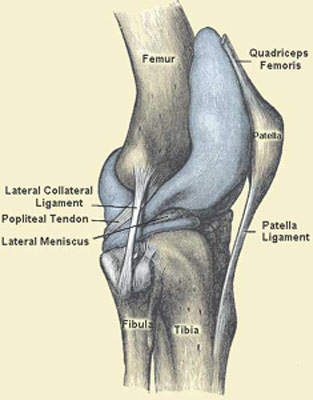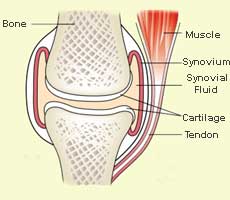Uh-oh, Runners Knee...
Patella femoral syndrome - runners knee to me and you - is a painful condition that can sometimes mean taking long breaks from running. But it’s not all doom and gloom, it is treatable and (you will be happy to know) there are things you can do to help prevent it
Here you will find running tips and advice about the injury, examine what it actually is - the causes of it, the symptoms, the do's and dont's...
First though, let’s take a quick refresher course
on how your knee is put together and how it should run smoothly – this
should give us a better idea of what’s going on ;-)
How The Knee Works

The knee has four bones-the Femur (thigh bone) which is connected by ligaments to the Fibula (calf bone), the Patella (kneecap) which is secured to the femur and the tibia (shin bone) and slides within the femoral groove (front-tip of femur); cartilage and synovial fluid make it all a nice smooth movement
The knee is a pivotal-hinge joint, this means that as well as flexing and extending it also rotates slightly and this is where the trouble usually begins..!
What Causes Runners Knee?
The knee has to pivot slightly as well as bend up and down, so the kneecap is embedded in tendon tissue and it sits nicely in the groove at the lower front end of the thigh bone, this groove is covered in cartilage, surrounded by fluid and kept stabilized by muscles, ligaments and tendons, all very cosy…
But if you repeatedly bash it out running, or any activity including walking, cycling, or just sitting for long periods, you will cause wear and tear – this is why you should strengthen the muscles surrounding the knee if you do regular exercise (more about this in Runners Knee Part 2)
The cartilage gets worn down and the fluid around the joint depletes, this causes the bones to grind against each other and the movements become irregular, thus causing more wear
And that is just good old repetitive strain - there are other considerations to throw into the pot as well…

The synovial fluid can become infected, this is incredibly painful and will cause the knee to look very red and will feel hot, as well as depleting the fluid and causing a grinding feeling and pain
And as if all that is not enough there is always secondary injury due to conditions such as shin splints or hip problems, over compensating on one knee, or misalignment of the patella due to previous dislocation
So how do you know if you have runner’s knee, what do you need to look out for?
Running Tips HQ:
If you are weary about running on a sore knee, try doing half of your normal mileage and also have an extra rest day. Then, if the pain subsides, gradually build back up
Symptoms Of Patella Femoral Syndrome
- Popping or grinding sensation felt on movement
Pain is most often felt behind and above the kneecap - Pain when walking up and downhill or stairs but mostly on the ascending
- Hurts to push onto the kneecap, but no such sensitive place on the side of the knee
- The pain has gradually got worse and more frequent over months or even years
- Bending the knee hurts
If these symptoms sound familiar you may have runners knee – don’t worry, help is at hand! – in Part 2 we shall look at the treatments and of course, prevention
